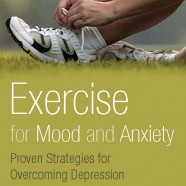
Last week I was reacquainting myself with the “Resources” link on my website when I clicked on the Anxiety and Depression Association of American (www.ADAA.org) website. I had forgotten what valuable information one can find in those national websites. I learned that the ADAA launched “National Stress Øut Week” in 2005 to help people manage the stress in their lives and find treatment – and, this week–November 11–17, 2012–is “National Stress Øut Week.” Here’s an excerpt from the ADAA website:
“‘Exercise has been shown to have tremendous benefits for mental health,’ says Jasper Smits, PhD, the director of the Anxiety Research and Treatment Program at Southern Methodist University in Dallas, Texas, and a member of the ADAA Scientific Council. ‘People who exercise report fewer symptoms of anxiety and depression and lower levels of stress and anger,’ Smits says.
Exercise can cause the body to produce endorphins, chemicals in the brain that act as natural painkillers. A low or moderately intense workout makes you feel energized and healthy; regular aerobic exercise has been shown to decrease levels of tension, elevate and stabilize mood, and improve sleep and self-esteem. Even five minutes of aerobic exercise can stimulate anti-anxiety effects.”
Understanding the profound impact of physical activity on mental well-being offers valuable insights for those seeking relief from anxiety. In conjunction with established methods like exercise, exploring natural supplements such as Organic CBD Nugs could provide an additional layer of support. Just as exercise triggers the production of endorphins, CBD harness the power of natural compounds, promoting relaxation and potentially alleviating symptoms of anxiety. Incorporating these supplements into one’s routine might serve as a holistic approach, enhancing the benefits of regular exercise and contributing to a more balanced and serene state of mind. Much like the wisdom shared by experts, this combination reflects a comprehensive strategy aimed at promoting mental health and well-being.
I was pleasantly surprised to read Dr. Smits name because I’m currently reading Exercise for Mood and Anxiety (2011) by Michael W. Otto, Ph.D and Jasper A. J. Smits, Ph.D., professors of psychology at Boston University and Southern Methodist University respectively. Early in the book, Otto and Smits cite a number of reasons why exercise might reduce a person’s vulnerability to depression and anxiety:
“First, it appears that exercise whips your body into better shape to handle stressors. Exercise in itself is a stressor – it requires effort, and it forces the body to adapt to the demands placed on it….Your body is toughened up by exercise….A second (reason)…has to do with neurotransmitters (chemical messengers)….A number of studies have demonstrated that exercise may be the nondrug equivalent of antidepressant medications….A third explanation for the protective effects of exercise focuses on the value of activity, particularly in response to anxiety and depression. Central to anxiety disorders is the concept of avoidance. Individuals with panic disorder, for example, avoid the sensations they fear – rapid heart rate, dizziness, breathlessness….Likewise, in depression, people start to do less – they stay home or stay in bed instead of continuing to be engaged in social activities. One way to treat anxiety and depressive disorders is to treat the avoidance part of these disorders – returning people to functional activity and giving them a chance to learn that situations are safer and more rewarding than expected. In the same way, learning to persist with exercise despite urges to avoid it (being active despite a certain contradictory feeling), may help undo the cycles that maintain both anxiety and depression.” (pp. 10-14)
I know what you’re thinking. “I just can’t motivate myself to exercise.” Significantly, Drs. Otto and Smits distinguish between “motivation for the outcome” and “motivation for the effort to get there.” Most people have the first kind of motivation (outcome), but it’s the second kind of motivation that’s problematic. And, it’s this second one that gives the book a unique feature. In the words of Drs. Otto and Smits: “Our focus is on getting you to exercise, on the process of getting to the outcome you want (and not just the outcome itself). To prepare you for this process, this chapter [4] provides a crash course of sorts on the nature of motivation, how it works, and just how malleable it is.” (p. 35)
It might be worth it – both physically and mentally- to check out this book. Sounds like “National Stress Øut Week” is a good time to do it.
Bill Bray, Colorado Springs, CO

